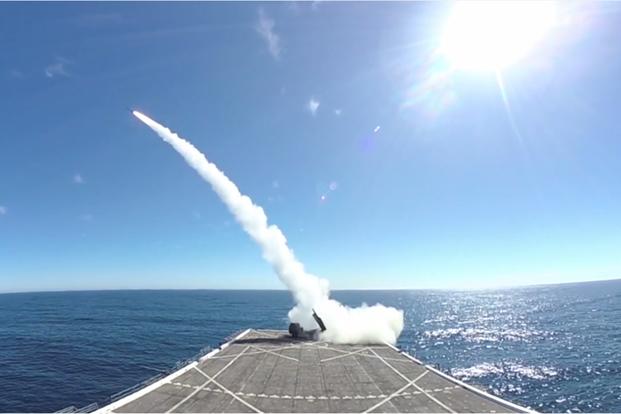The Marine Corps made headlines and delighted tech blogs in October when it obliterated a ground target with a high-mobility artillery rocket system launched from the amphibious transport dock USS Anchorage nearly 43 miles away.
But the service's plans for integrating precision fires into maritime operations extend well beyond a dazzling proof-of-concept test.
To start, there will be more shipboard HIMARS tests in the near future, said Maj. Gen. Eric Smith, commanding general of the 1st Marine Division.
"We'll do it a couple of times, so proof of concept has to be done a few times," Smith told Military.com following a Marine Corps Association and Foundation event near Washington, D.C. in November. "Once it's proven that we can steadily always do that, then the answer is, it's unlimited."
Related content:
- Top Marine Wants to Fire Anti-Ship Missiles From HIMARS Launcher
- In a First, Marines Shoot HIMARS Rocket from Amphibious Ship
- Military.com Equipment Guide: M142 HIMARS
Those follow-up tests have yet to be scheduled, but will involve different weather conditions and parameters, Smith said.
"There's no decision to make other than reprove the concept, make sure it's valid. Then the only decision is, where do you employ it, when do you employ it, how much do you use," he said. "The great thing is there isn't much to decide. We own the ships, we own the HIMARS, we own the Marines shooting the HIMARS, and it works."
In addition to targeting accuracy, the recent test did allow Marine officials to iron out challenges specific to shooting rockets from ships.
Planners first had to adjust targeting software to account for firing from a moving position, developing a capability that effectively did not exist before in the Marine Corps, said Lt. Col. Bradley Sams, program manager for fires at Marine Corps Systems Command.
Testers found they also had to use a blast pad to prevent the deck from being damaged by the rocket launcher.
But firing HIMARS off a ship may not be the end game the Marine Corps wants to pursue, according to the Marine Corps' experts on the topic.
One potential problem with a plan to deploy the rocket system aboard amphibious ships is the space the system takes up. The launcher itself sits on the back of a 22-foot truck frame and comes with dense, rectangular rocket pods. It typically is deployed with a platoon of Marines.
"A platoon is a big footprint," said Lt. Col. Dale Butler, artillery and rockets capabilities integration officer at Marine Corps Systems Command. "Just putting 11 of the pods for HIMARS displaces one-fifth of the ammo storage capacity [on an amphibious ship]. A platoon has the capability of carrying 18 pods of ammunition. There's a lot of second- and third-order effects that need to be scrubbed down."
The real advantage of the test, Butler said, was to demonstrate the Corps' capability to attack land-based targets from the sea, a concept designed to make the Marines more lethal as they operate increasingly in littoral environments. With that proven, the service may explore a variety of systems and munitions before settling on a solution or concept that works best.
Joe McPherson, fires deputy for Marine Corps Systems Command, said the Marine Corps is exploring targeting modifications to the existing guided multiple launch rocket system, or GMLRS, as well as the possibility of equipping the MGM-140 Army Tactical Missile System, or ATACMS, with a seeking device.
The Marine Corps is also interested in Raytheon's Naval Strike Missile, an anti-ship and land attack missile that has been tested aboard the Navy's littoral combat ship. The missile has a range of 100 nautical miles, more than double the effective range of HIMARS.
There's another option still on the table as well: using the vertical launching system, or VLS, cells that already exist aboard San Antonio-class amphibious assault ships to fire Tomahawks or other missiles. Both the Navy and the Marine Corps are interested in that capability, though a decision hasn't been made yet on a way forward.
Once the weapons system is decided upon, employment is another question. The Marine Corps may also explore anti-ship fires capabilities from land or moving HIMARS via amphibious ships to reach land-based destinations.
While deploying HIMARs for routine Marine Expeditionary Unit deployments might mean valuable space lost and a lot of downtime for the weapons system, Butler said he could see it being deployed with a larger Marine Expeditionary Brigade for forcible entry operations. He is also interested in putting the rocket launchers on other maritime platforms, such as Navy logistics ships, to create a sort of floating archipelago of fires in a specific region.
In a hearing before the panel of the House Armed Services Committee, the deputy commandant for Marine Corps Plans, Policies and Operations, Lt. Gen. Brian Beaudreault, talked about finding ways to extend the Marines' shooting range from the sea up to 400 miles.
"The coin of the realm of the future is long-range precision fires," he said.
-- Hope Hodge Seck can be reached at hope.seck@military.com. Follow her on Twitter at @HopeSeck.










